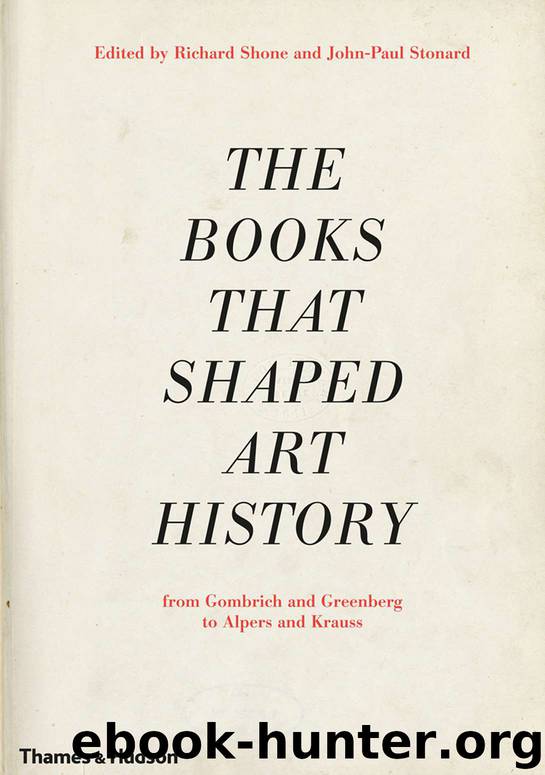The Books that Shaped Art History: From Gombrich and Greenberg to Alpers and Krauss by Shone Richard & Stonard John-Paul

Author:Shone, Richard & Stonard, John-Paul [Shone, Richard]
Language: eng
Format: epub
Publisher: Thames & Hudson
Published: 2013-04-05T00:00:00+00:00
Interior spread showing drawings by Pisanello and after Leonardo da Vinci. From Michael Baxandall, Painting and Experience in Fifteenth Century Italy: A Primer in the Social History of Pictorial Style, 1972. (Oxford University Press)
It is in the pages that follow, in which Baxandall discusses fifteenth-century paintings of the Annunciation in the light of contemporary sermons, that he achieves a more precise and successful way of thinking about the contribution the public might bring to reading and empathising with an image. By following the phases of the ‘mystery’ of the Annunciation and the gamut of emotions experienced by the Virgin Mary, as clearly laid out by the preacher, we apprehend what the fifteenth-century beholder might have brought to paintings of this subject.
Many scholars in their books and countless students in their essays have used these pages to sharpen their own accounts of what is happening in a fifteenth-century religious painting. Baxandall’s preference for drawing upon sermons to gauge what a relatively literate public might find vividly memorable and emotionally moving in a painting is rather different from the emphasis of later scholars on liturgy and cult. He restores religious images to a central place in any discussion of fifteenth-century art, but he does not separate them from the skills and perceptions that informed daily life.
At the end of Part I, after acknowledging the limitations of contractual documents in affording any sense of the hallmarks of a painter’s style, Baxandall turned to a description of the qualities of contemporary painters written by an agent of the Duke of Milan (pp.23–27). In his commentary on this memorandum he brings into play the kind of linguistic analysis of texts that he had deployed in Giotto and the Orators. He concludes on a typically candid note of caution, observing that ‘when we look at the paintings (by Botticelli, Filippino, Ghirlandaio) we can give a sense, our sense, to the Milanese agent’s remarks, but it is unlikely that this sense is his’ (p.27).
This introduces an abiding interest in how different languages and their syntax inflect or channel perceptual priorities. Deploying his own agile command of language Baxandall teased out these distinctions, savouring the strangeness and particularity of words, from Giotto and the Orators to his final collection of articles, Words for Pictures (2003), and his posthumously published novel, A Grasp of Kaspar (2010).21 And it was language which was the principal focus of Part III of Painting and Experience, entitled ‘Pictures and Categories’.
In Giotto and the Orators he had explored how the different syntax and sentence structure of Classical Latin and vernacular Italian constrained or enabled critical discrimination, and it is this that he takes up again. But alerted by Baxandall’s tributes to Wölfflin we may now recognise that the idea of structuring his discussion around sixteen terms drawn from Cristoforo Landino’s description of the painters of his time – including ‘ease, grace, ornateness, variety, foreshortening and blitheness’ – echoes the last section of Classic Art where Wölfflin described ‘the new pictorial form’ under four heads
Download
This site does not store any files on its server. We only index and link to content provided by other sites. Please contact the content providers to delete copyright contents if any and email us, we'll remove relevant links or contents immediately.
The Secret History by Donna Tartt(16738)
Red Sparrow by Jason Matthews(4728)
Harry Potter 02 & The Chamber Of Secrets (Illustrated) by J.K. Rowling(3306)
In a Sunburned Country by Bill Bryson(2971)
Figure Drawing for Artists by Steve Huston(2824)
The Daily Stoic by Holiday Ryan & Hanselman Stephen(2731)
Drawing Cutting Edge Anatomy by Christopher Hart(2708)
The Roots of Romanticism (Second Edition) by Berlin Isaiah Hardy Henry Gray John(2582)
Japanese Design by Patricia J. Graham(2582)
Make Comics Like the Pros by Greg Pak(2448)
Stacked Decks by The Rotenberg Collection(2303)
Harry Potter and the Deathly Hallows (7) by J.K. Rowling(2249)
Harry Potter and the Prisoner of Azkaban (Book 3) by J. K. Rowling(2170)
On Photography by Susan Sontag(2157)
Draw-A-Saurus by James Silvani(2124)
Tattoo Art by Doralba Picerno(2101)
Foreign Devils on the Silk Road: The Search for the Lost Treasures of Central Asia by Peter Hopkirk(2074)
Churchill by Paul Johnson(2032)
The Traveler's Gift by Andy Andrews(2031)
